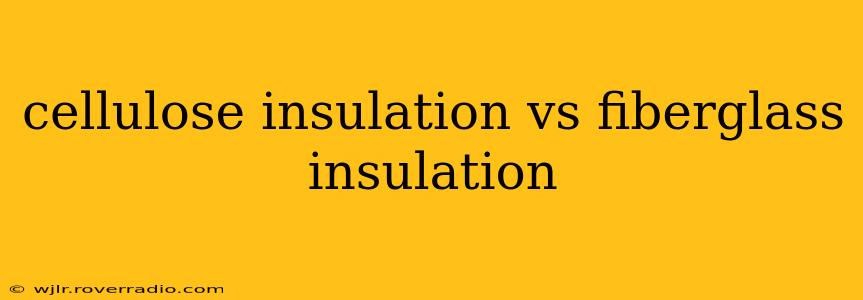Choosing the right insulation for your home is crucial for energy efficiency, comfort, and long-term cost savings. Two popular options are cellulose and fiberglass insulation, each with its own set of advantages and disadvantages. This comprehensive guide will delve into the key differences, helping you make an informed decision for your specific needs.
What is Cellulose Insulation?
Cellulose insulation is a sustainable material made from recycled paper products, treated with borates to prevent pest infestations and fire. It's blown into wall cavities and attics, conforming to the shape of the space for optimal coverage and minimal air gaps. This makes it particularly effective in filling irregularly shaped areas.
What is Fiberglass Insulation?
Fiberglass insulation, a synthetic product, is made from glass fibers bonded together. It's available in batts (rolls), blankets, and loose-fill forms. Batts and blankets are typically used in wall and attic spaces, while loose-fill fiberglass is blown into cavities similarly to cellulose.
Cellulose Insulation vs. Fiberglass Insulation: A Detailed Comparison
Let's break down the key differences between these two common insulation types:
R-Value:
- Cellulose: Offers excellent thermal resistance (R-value), comparable to or even exceeding fiberglass, depending on the density and installation. A properly installed cellulose insulation layer can provide a high level of thermal performance.
- Fiberglass: Provides good thermal resistance, but the R-value can vary depending on the thickness and density of the material. Higher density generally equates to a higher R-value.
Cost:
- Cellulose: Generally less expensive than fiberglass insulation, particularly when factoring in labor costs for installation, especially for larger projects. The lower cost makes it an attractive choice for budget-conscious homeowners.
- Fiberglass: Can be more expensive upfront, especially for larger projects that require more material. Installation costs can also be significant.
Installation:
- Cellulose: Requires specialized equipment for blowing into walls and attics, usually requiring professional installation. However, the even distribution often minimizes the need for extensive labor.
- Fiberglass: Batts and blankets are relatively easy for DIY installation, though professional installation is recommended for optimal results, especially in complex wall systems. Loose-fill fiberglass, like cellulose, requires specialized equipment.
Environmental Impact:
- Cellulose: A highly sustainable option, made from recycled materials, minimizing environmental impact during manufacturing. The use of recycled paper also reduces landfill waste.
- Fiberglass: Manufacturing fiberglass does have some environmental impact, due to energy consumption and glass fiber production. However, its lifespan and effectiveness in reducing energy consumption contribute to a reduced environmental footprint over time.
Moisture Resistance:
- Cellulose: Can absorb some moisture, but borate treatment helps protect against mold and mildew growth. Proper ventilation is still essential to prevent moisture buildup.
- Fiberglass: Not resistant to moisture and can lose its insulating properties if exposed to significant moisture. This highlights the importance of proper vapor barriers.
Fire Resistance:
- Cellulose: Treated with borates to inhibit fire spread and reduce flammability.
- Fiberglass: Generally considered to be non-combustible.
Sound Absorption:
- Cellulose: Offers superior sound absorption properties compared to fiberglass insulation, making it a great choice for noise reduction.
- Fiberglass: Provides some sound dampening, but not as effectively as cellulose.
How Much Does Cellulose Insulation Cost?
The cost of cellulose insulation varies depending on several factors including the quantity needed, location, and labor costs. It’s best to obtain quotes from multiple insulation contractors in your area to get a better understanding of the costs involved.
How Much Does Fiberglass Insulation Cost?
Similar to cellulose, fiberglass insulation cost is influenced by the amount needed, location, and installation method. DIY installation can reduce costs, but professional installation often guarantees better results and a longer lifespan.
Which Insulation is Better for My Attic?
Both cellulose and fiberglass are suitable for attic insulation. However, cellulose's ability to fill irregular spaces effectively might be more advantageous in attics with complex geometries.
Which Insulation is Better for My Walls?
Both options are effective for wall insulation. The choice often depends on budget, accessibility for installation, and desired level of sound dampening.
Is Cellulose Insulation Better Than Fiberglass?
There’s no single "better" insulation; the ideal choice depends on your specific needs and priorities. Consider your budget, environmental concerns, installation ease, and desired R-value when making your decision.
By carefully weighing these factors, you can choose the insulation that best meets your home's needs and your budget. Remember to consult with qualified insulation professionals for accurate assessments and proper installation to maximize the benefits of your chosen insulation.
